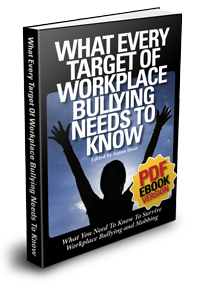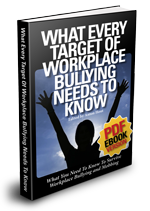Twelve Reflections On Three Years Of Counselling People Who Have Been Mobbed At Work
By Richard Schwindt M.S.W.,R.S.W.
It has been three years now since I transitioned from target to healer in situations of workplace abuse. I have received emails and comments from people who have read my articles or seen my videos. I have seen many targets in counselling in varying states of disrepair, from anxious to depressed; some suicidal. Most but not all have been from the public sector. I have seen women and men in roughly equal numbers. Many of my clients have suffered from stress related illnesses; some of them quite serious. Here are some thoughts in no particular order.
1. You meet alot of good people. Targets are not always easy to counsel but they are usually resourceful likeable people. Characteristics that made them targets also make them survivors.
2. Counselling is usually short term. I'm not quite sure why but I usually see targets for a shorter period of time than my other clients. One theory: as people who function well in general, many targets use me more as a consultant than psychotherapist. I am fine with that. How long people come also depends on how deep they are into the experience. More exposure, more damage to fix.
3. Targets are usually caught up in the pain of the moment. They are preoccupied with what is happening to them. Or if they have left the abusive workplace, what has been done. Part of the clinical challenge is to remove them from that nightmare and put them back in the world where they belong.

Richard Schwindt M.S.W., R.S.W. is a psychotherapist and hypnotherapist specializing in the emotional recovery of targets of workplace bullying and mobbing. He can utilize Skype and Paypal for Canadian clients. For more information visit www.richardschwindt.ca
4. Targets are reluctant to stop fighting and move on. This is the single greatest clinical challenge; comparable to the abused woman who won't leave her spouse. A client asked me last year how these situations end. I did a quick mental review in my head: of the last ten cases I recalled right away either the target left the workplace, or the leader of the abusers was promoted. I have seen exceptions but they're not common.
5. In a society where abused women are seen as a critical concern, women abused in the workplace are ignored. Of course men are abused too but realistically women normally take the lead in labelling abuse for what it is (eg many abused boys receive help only when their abused sisters blow the whistle). And whoever the perp, an abused woman is an abused woman. Workplace abuse identified as a "woman's issue" would change both the priority and sophistication of the response.
6. Most workplace measures to address "bullying" are worse than useless. Some (not all) are well intended but all ignore the two reasons why tribunals, hearings and jolly reconciliation meetings do so much harm. One, the target is usually tired and broken - in no shape to participate. Second - let's face it - in these situations might is right. And power will almost inevitably line up against the victim.
7. Most clinicians do not understand the dynamics of mobbing. They treat it symptomatically which is helpful up to a point but neglects the dynamics of the mob, the inner psychological experience of the client and twenty-five years of psychological research on mobbing, mostly in Europe. I attribute this to a lack of training, or training that is psychologically unsophisticated or straight from the HR/policy playbook. Truth is, clinicians are bullied too, particularly those who think for themselves. My field and especially my profession are doing a great impression of the "see no evil" monkeys.
8. In mobbing cases you can't separate the psychological from the social from the political. You need to assess and understand all of it.
9. Bullies run in packs and that makes most of the situations that I see mobbing. The "bully" almost always has support from colleagues, subordinates and especially organizational leadership. Current "anti-bullying" measures have been learned, integrated and turned against the targets.
10. My clients have reported help from supportive spouses, organizational mentors, renegade bystanders and sometimes Unions. When I meet a target who tells me that the organizational leadership has said "enough" and changed the culture I'll get back to you. Likewise when I meet a remorseful bully or bystander.
11. Organizational leaders that truly set out to change an abusive culture would lose some superficial control but sow huge gains in productivity and creativity. The system is losing many of its best people. As a manager I would be thrilled to hire the quality workers who come to me for counselling as targets.
12. I continue to see my healers from time to time, but turning my energy to counselling others was a healthy move for me. I have seen distressed people and some who have been made permanently ill by the abuse. That said, most of my cases have ended well. Targets are resourceful people and I have witnessed the human spirit at its best. It is, in the end, inspiring work.
Richard Schwindt M.S.W., R.S.W. is a social worker in private practice in Kingston, Ontario. His website is www.richardschwindt.ca
See Also:
5 Part Series by Richard Schwindt:
Getting Help To Come Back From The Dead
Seven Principles For Recovery
Dealing With Anxiety and Panic Attacks
Thinking Makes It So
Forgiveness











